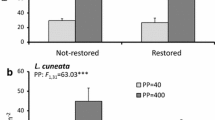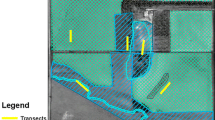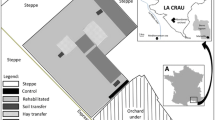Abstract
Over the last 60 years changes to the management of species-rich mesotrophic grasslands have resulted in the large-scale loss and degradation of this habitat across Europe. Restoration of such grasslands on agriculturally improved pastures provides a potentially valuable approach to the conservation of these threatened areas. Over a four-year period a replicated block design was used to test the effects of seed addition (green hay spreading and brush harvest collection) and soil disturbance on the restoration of phytophagous beetle and plant communities. Patterns of increasing restoration success, particularly where hay spreading and soil disturbance were used in combination, were identified for the phytophagous beetles. In the case of the plants, however, initial differences in restoration success in response to these same treatments were not followed by subsequent temporal changes in plant community similarity to target mesotrophic grassland. It is possible that the long-term consequences of the management treatments would not be the establishment of beetle and plant communities characteristic of the targets for restoration. Restoration management to enhance plant establishment using hay spreading and soil disturbance techniques would, however, still increase community similarity in both taxa to that of species-rich mesotrophic grasslands, and so raise their conservation value.




Similar content being viewed by others
References
Bakker JP, Berendse F (1999) Constraints in the restoration of ecological diversity in grassland and heathland communities. Trends Ecol Evol 14:63–68
Blackstock TH, Rimes CA, Stevens DP, Jefferson RG, Robertson HJ, Mackintosh J, Hopkins JJ (1999) The extent of semi-natural grassland communities in lowland England and Wales: a review of conservation surveys 1978–1996. Grass Forage Sci 54:1–18
Coulson SJ, Bullock JM, Stevenson MJ, Pywell RF (2001) Colonization of grassland by sown species: dispersal versus microsite limitation in responses to management. J Appl Ecol 38:204–216
Cummings J, Reid N, Davies I, Grant C (2005) Adaptive restoration of sand-mined areas for biological conservation. J Appl Ecol 42:160–170
Davis ALV, van Aarde RJ, Scholtz CH, Delport JH (2003) Convergence between dung beetle assemblages of a post-mining vegetational chronosequence and unmined dune forest. Restor Ecol 11:29–42
De Deyn GB, Raaijmakers CE, Zoomer HR, Berg MP, de Ruiter PC, Verhoef HA, Bezemer TM, van der Putten WH (2003) Soil invertebrate fauna enhances grassland succession and diversity. Nature 422:711–713
Duffey E, Morris MG, Sheail J, Ward LK, Wells DA, Wells TCE (1974) Grassland ecology and wildlife management. Chapman & Hall, London
Edwards A, Mortimer SR, Lawson CS, Westbury DB, Harris SJ, Woodcock BA, Brown VK (2006) Hay strewing, brush harvesting of seed and soil disturbance as tools for the enhancement of botanical diversity in grasslands. Biol Conserv 134:372–382
Hirst RA, Pywell RF, Marrs RH, Putwain PD (2005) The resilience of calcareous and mesotrophic grasslands following disturbance. J Appl Ecol 42:498–506
Hoffman A (1950–1958) Coleopteres Curculionides (Premiere 1–3; Fauna de France 52). Paul Lechevalier, Paris
Jones AT, Hayes MJ (1999) Increasing floristic diversity in grassland: the effects of management regime and provenance on species introduction. Biol Conserv 87:381–390
Krebs CJ (1999) Ecological methodology. Addison Wesley, Menlo Park, CA
Manchester S, Treweek J, Mountford O, Pywell R, Sparks T (1998) Restoration of a target wet grassland community on ex-arable land. In: Joyce CB, Wade PM (eds) Grasslands: biodiversity management and restoration. Wiley, Chichester, UK, pp 277–293
Manchester SJ, McNally S, Treweek JR, Sparks TH, Mountford JO (1999) The cost and practicality of techniques for the reversion of arable land to lowland wet grassland—an experimental study and review. J Environ Manage 55:91–109
Mitchell RJ, Auld MHD, Le Duc AG, Marrs RH (2000) Ecosystem stability and resilience: a review of their relevance for the conservation management of lowland heaths. Perspec Plant Ecol Evol Syst 3:142–160
Morris MG (2003) An annotated checklist of British Curculionoidea (Col.). Entomol Mon Mag 139:193–225
Mortimer SR, Booth RG, Harris SJ, Brown VK (2002) Effects of initial site management on the Coleoptera assemblages colonising newly established chalk grassland on ex-arable land. Biol Conserv 104:301–313
Pywell RF, Bullock JM, Roy DB, Warman LIZ, Walker KJ, Rothery P (2003) Plant traits as predictors of performance in ecological restoration. J Appl Ecol 40:65–77
Rodwell JS (ed) (1992) British plant communities. Grassland and montane communities, vol 3. Cambridge University Press, Cambridge
Stace C (1997) Field flora of the British Isles, 2nd edn. Cambridge University Press, Cambridge
Stevenson MJ, Ward LK, Pywell RF (1997) Re-creating semi-natural communities: vacuum harvesting and hand collection of seed on calcareous grassland. Restor Ecol 5:66–76
Strejcek J (1993) Chrysomelidae. In: Jelínek J (ed) Check-list of Czechoslovack insects IV (Coleoptera). Vít Kabourek, Sokolská, pp 123–132
ter Braak CJF, Šmilauer P (2002) CANOCO reference manual and CanoDraw for Windows user’s guide. Centre for Biometry Wageningen, Wageningen
Tilman D (1987) Secondary succession and the pattern of plant dominance along experimental nitrogen gradients. Ecol Monogr 57:189–214
Walker KJ, Stevens PA, Stevens DP, Mountford JO, Manchester SJ, Pywell RF (2004) The restoration and re-creation of species-rich lowland grassland on land formerly managed for intensive agriculture in the UK. Biol Conserv 119:1–18
Wassenaar TD, Van Aarde RJ, Pimm SL, Ferreira SM (2005) Community convergence in disturbed subtropical dune forests. Ecology 86:655–666
Woodcock BA, Lawson CS, Mann DJ, McDonald AW (2006) Effects of grazing management on beetle and plant assemblages during the re-creation of a flood-plain meadow. Agric Ecosyst Environ 116:225–234
Woodcock BA, Potts SG, Pilgrim E, Ramsay AJ, Tscheulin T, Parkinson A, Smith REN, Gundrey AL, Brown VK, Tallowin JR (2007) The potential of grass field margin management for enhancing beetle diversity in intensive livestock farms. J Appl Ecol 44:60–69
Woodcock BA, Pywell R, Roy DB, Rose R, Bell D (2005a) Grazing management of calcareous grasslands and its implications for the conservation of beetle communities. Biol Conserv 125:192–202
Woodcock BA, Westbury DB, Potts SG, Harris SJ, Brown VK (2005b) Establishing field margins to promote beetle conservation in arable farms. Agric Ecosyst Environ 107:255–266
Young TP (2000) Restoration ecology and conservation biology. Biol Conserv 92:73–83
Acknowledgments
This project was funded by the UK Department for the Environment, Food and Rural Affairs (Defra) as part of project BD1441. We thank Keith Datchler of the Beech Estate for permission to use the experimental sites and his support and enthusiasm throughout the project, Chris and Roland Davis (Agrifactors Southern Ltd.) for assistance with installing the treatments, and Dawn Brickwood of the High Weald Meadows Initiative for continued support. Victoria Chapman, Tracy Gray, Katherine Robertson and Corin Wilkins assisted with sampling. Special thanks to Darren Mann, James Hogan and George McGavin at the Hope Entomological Collections, University Museum Oxford.
Author information
Authors and Affiliations
Corresponding author
Additional information
Communicated by W. Weisser.
Electronic supplementary material
Below is the link to the electronic supplementary material.
Rights and permissions
About this article
Cite this article
Woodcock, B.A., Edwards, A.R., Lawson, C.S. et al. Contrasting success in the restoration of plant and phytophagous beetle assemblages of species-rich mesotrophic grasslands. Oecologia 154, 773–783 (2008). https://doi.org/10.1007/s00442-007-0872-2
Received:
Accepted:
Published:
Issue Date:
DOI: https://doi.org/10.1007/s00442-007-0872-2




